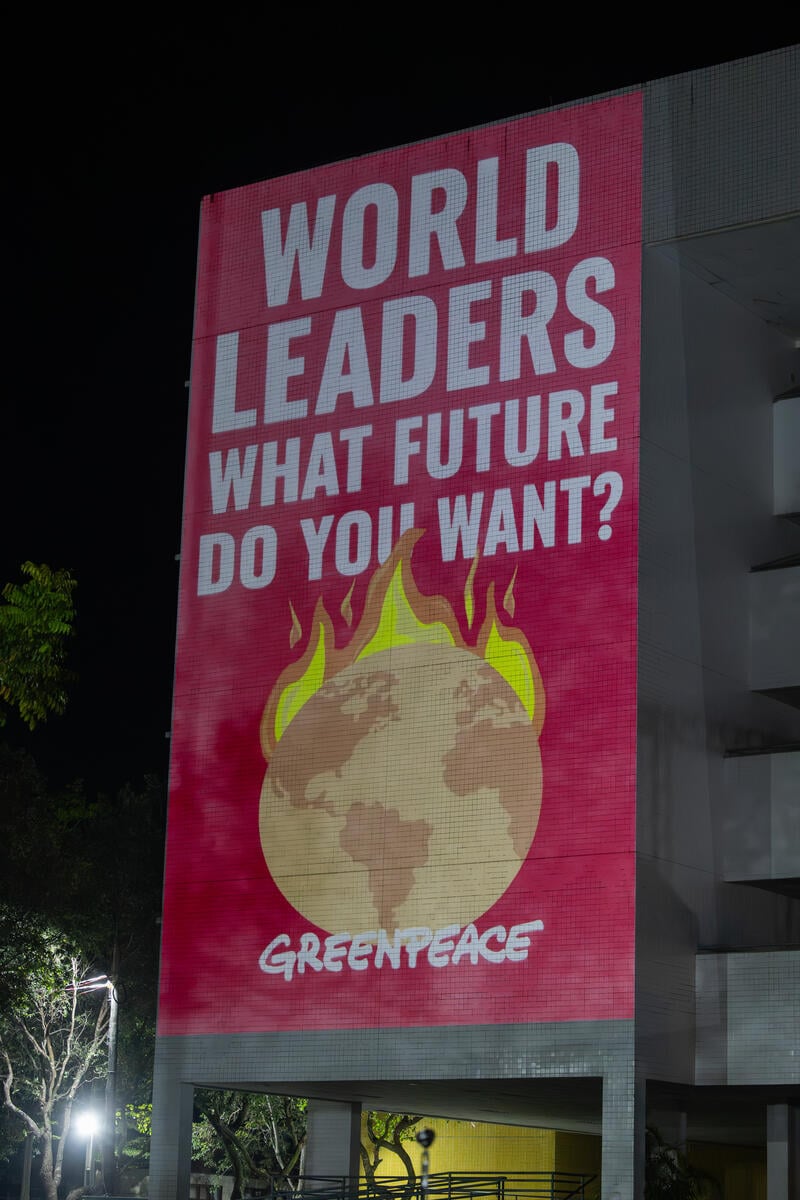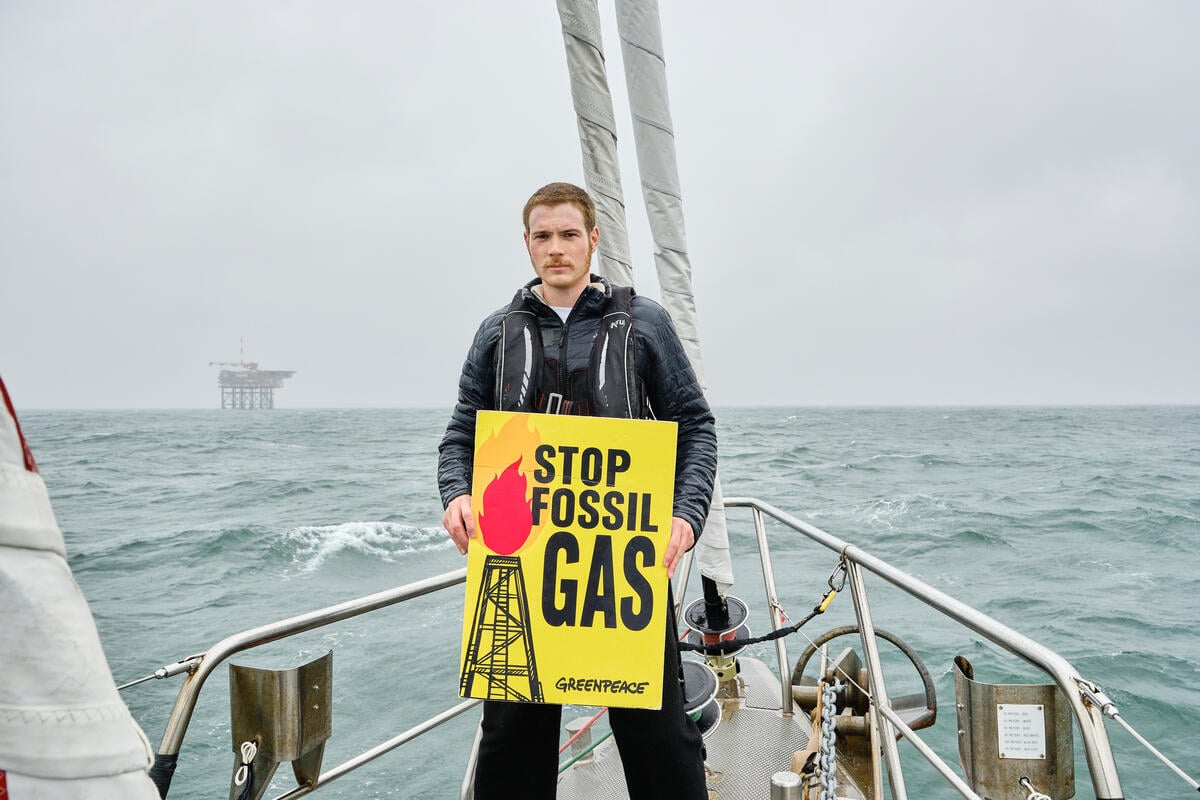The climate crisis has a price tag – and a responsible party. Since the Paris Agreement in 2015, greenhouse gas emissions by just five major investor-owned oil and gas companies are projected to produce economic damages that exceed US$5 Trillion.
This figure reflects impacts on people’s health and safety, costs to private property and public infrastructure, loss of work and school days, agricultural failure, disease outbreak and more. Some of these costs – like the loss of lives, cultural monuments and even indigenous languages – remain priceless.
Activists from Greenpeace organisations in Africa, Central and Eastern Europe, Denmark, India, Mexico, the Philippines and the USA have raised and carried a colossal Climate Bill in their cities, demanding governments hold polluters accountable and make them pay their fair share.
This global rally is a demand for climate justice, which is culminating at COP30 in Belém and in talks towards a UN Tax Convention, where world leaders have a historic opportunity to deliver climate justice.
Join us on a journey that follows the giant climate bill, as it builds pressure to make polluters – not ordinary people – pay the price for climate loss and damage.
1. New York, USA: the Climate Week – 20 September
The global tour kicked off in the financial heart of the world, during the New York Climate Week. Thousands marched together, carrying a giant invoice that itemised economic damages made worse by the climate crisis.
Mads Christensen, Executive Director of Greenpeace International, said: “No one is safe from deadly heatwaves, wildfires, toxic air, and rising seas. Yet those most sheltered from the crisis – the super-rich and oil and gas giants – keep profiting while the rest of us pay the price.”
The message was clear and directed at world governments: the companies driving the climate crisis must pay for the destruction they cause.
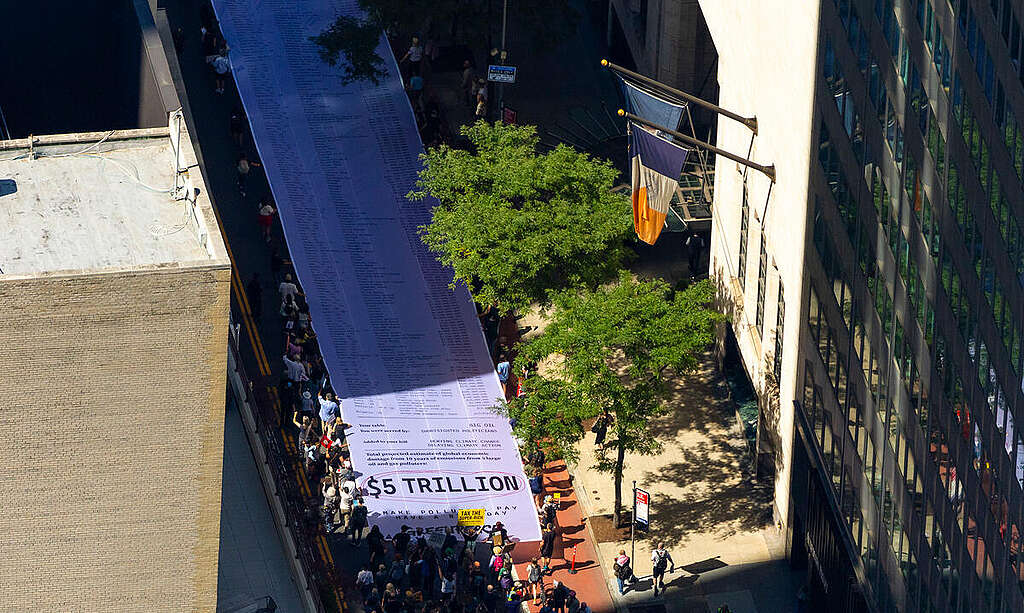
2. Cape Town, South Africa: Confronting polluters at the Africa Energy Week – 30 September
Activists took the Climate Bill to the lion’s den: the African Energy Week, which draws thousands of fossil fuel industry representatives, investors, and politicians. To confront this power center, Greenpeace Africa activists chained themselves to a giant green payment machine, demanding a just transition away from fossil fuels and challenging the industry’s narrative of energy poverty. The climate activists were dragged away by police, underscoring the high stakes of the campaign for climate justice on the continent.
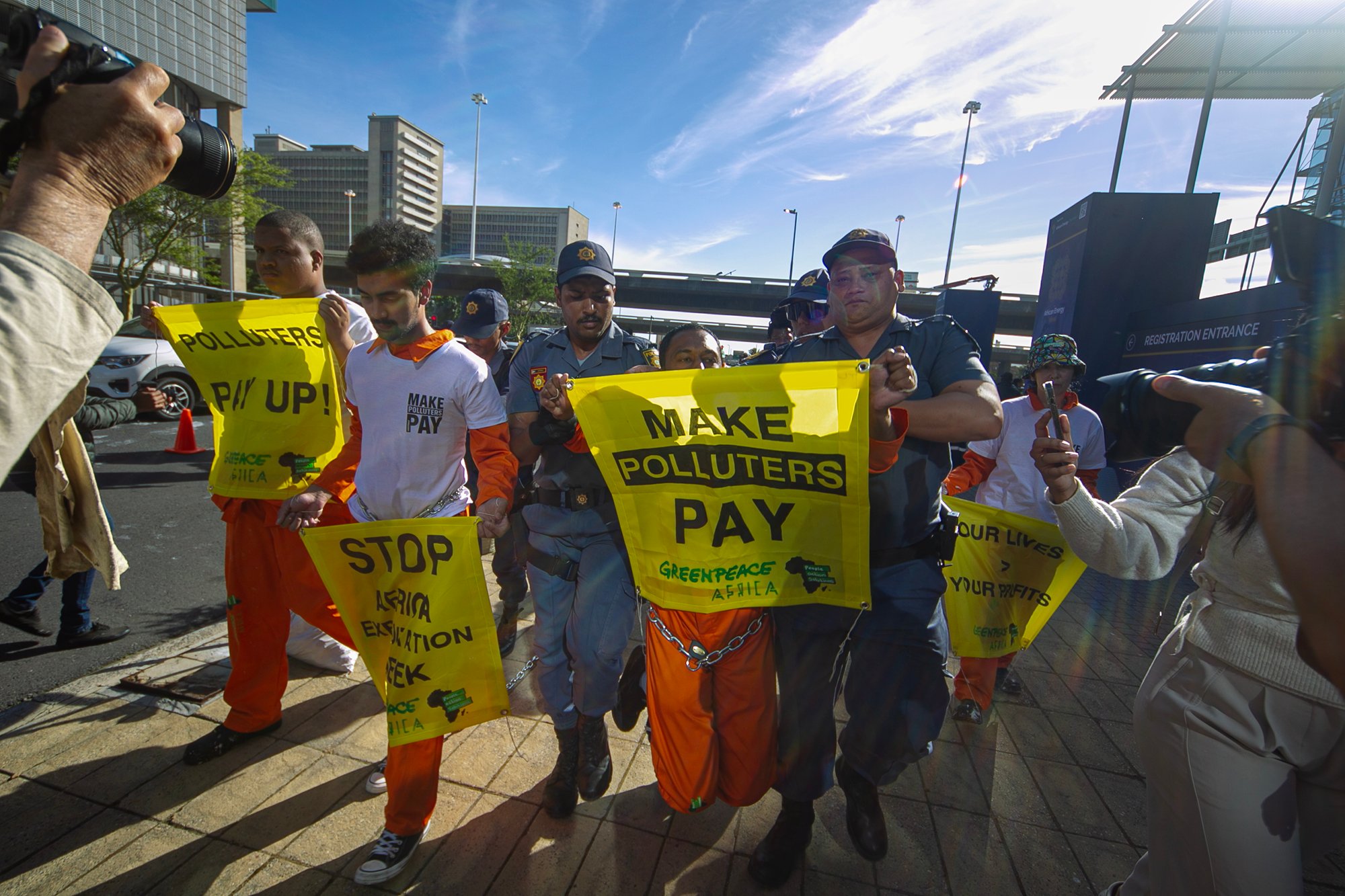
3. Copenhagen, Denmark: Confronting polluters at their offices – 30 September
Greenpeace Nordic activists used a 22-metre-high lift to show the giant bill in front of TotalEnergies’ Copenhagen offices. Using jack hammers, Greenpeace Nordic activists drilled into concrete pavers marked with the TotalEnergies logo, next to a banner that read “We’ll stop drilling when you start paying.”
Also in Denmark, volunteers dressed in a telephone costume with a money transferring app on the front. Volunteers used the costume to tell people on the streets how TotalEnergies, not ordinary people, should be paying the costs of climate damages and adaptation. Ordinary Danes are dealing with extreme rainfall and flooding that may cost EUR 6400 per household, while oil and gas corporations continue to swim in money. Their profits – our loss.
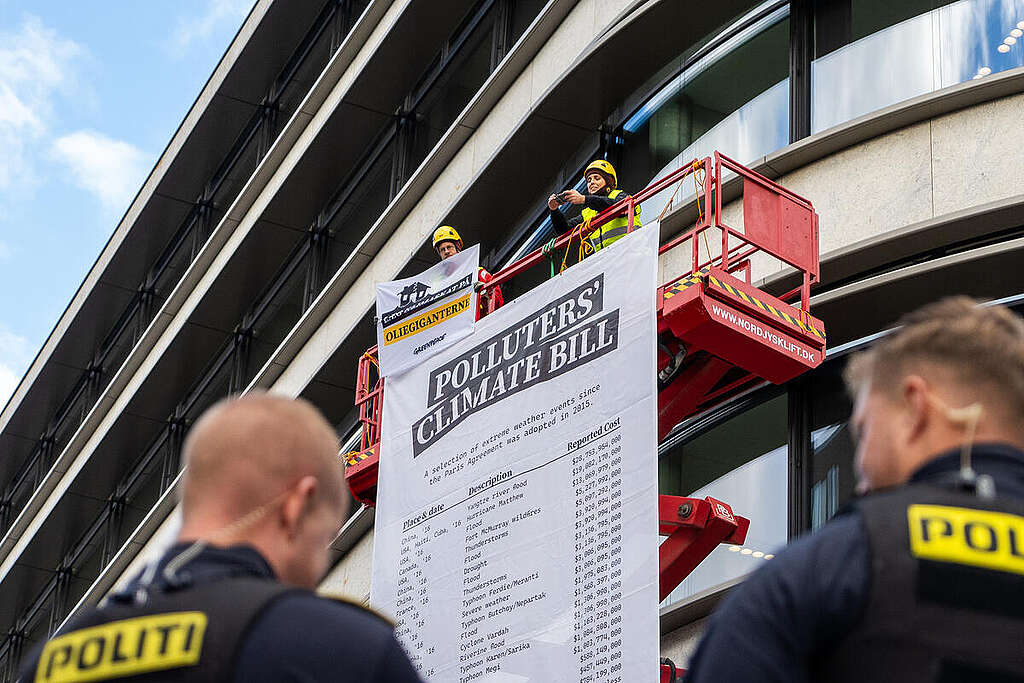
4. The Philippines: Typhoon survivors demand polluters pay – 7 October
The Philippines is one of the most climate-vulnerable nations in the world. Climate survivors and community representatives unfurled the massive US$5 Trillion receipt, itemising the costs of disasters like Typhoon Odette, and called on President Ferdinand ‘Bongbong’ Marcos Jr. to push for accountability and ensure funding for affected communities. The action occurred at the venue of a critical meeting for the Loss and Damage Fund. Greenpeace Philippines added a “corruption premium” to the bill, reflecting a recent scandal in misusing flood control measures.

5. Bucharest, Romania: A warning against the EU’s largest fossil gas project – 25 October
Greenpeace Romania activists mounted the giant climate bill in bus stops across Bucharest. The message focused on the oil and gas corporation OMV. Along with Romgaz, OMV seeks to launch the Neptun Deep project in 2027, which is expected to be the largest fossil gas project in the EU. According to an estimate prepared for Greenpeace Romania, the project would pose a threat to the EUʼs carbon neutrality target and lock its economy to an outdated and polluting energy system, at the expense of the health and safety of people around the world.
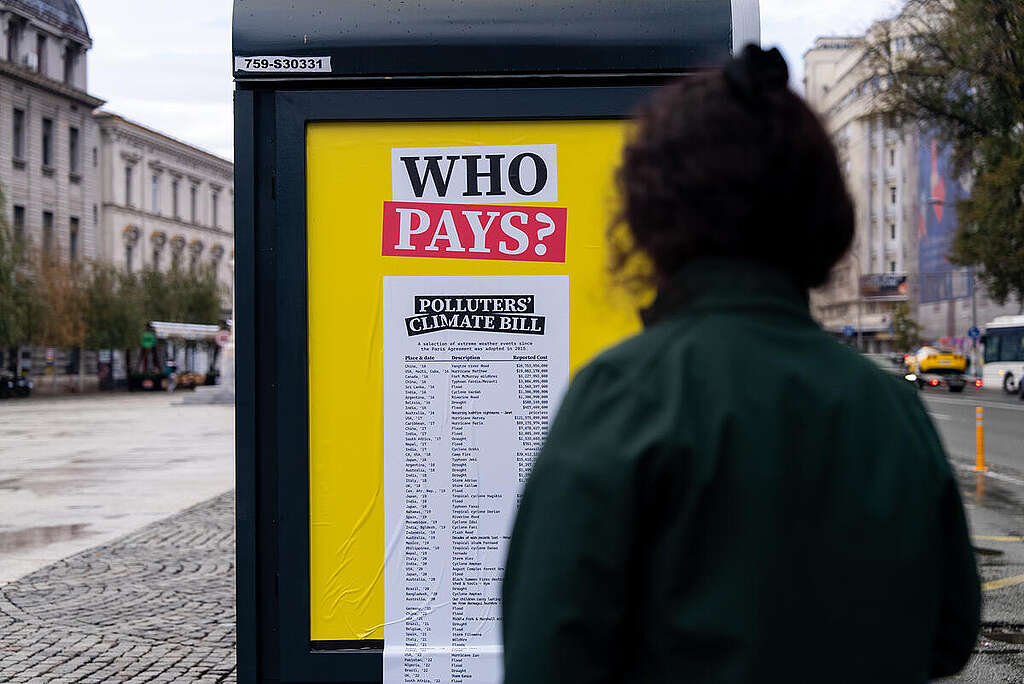
6. Altadena, California, USA: Remembering the LA fires – 28 October
Greenpeace USA activists deployed the Climate Bill in Altadena, California, a community devastated by the 2025 Los Angeles fires.
In January 2025, a rare series of major wind-wildfires ravaged Los Angeles County, burning more than 50,000 acres, destroying more than 17,000 structures, and forcing up to 180,000 people to evacuate at their peak, according to state agencies. It was among the costliest climate disasters in United States history, according to AccuWeather. The deadly fires were fuelled by fossil fuel-driven climate change, combined with a long period of no rain, low humidity, and powerful Santa Ana winds.
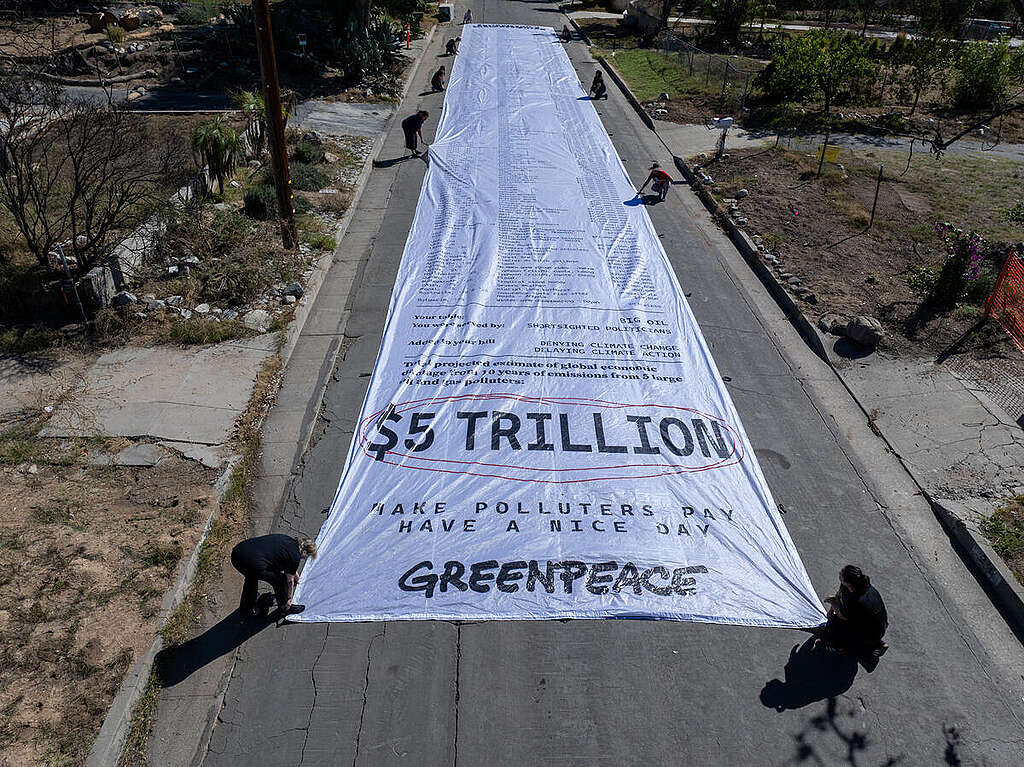
7. Rome, Italy: Redressing the historical city for climate justice – 29 October
The climate bill’s journey continued in Piazza di Spagna in Rome, where Greenpeace Italy activists highlighted the culpability of ENI – the Italian oil and gas giant – in projected climate loss and damages. The latest stop keeps the issue high on the agenda for European leaders ahead of the international climate negotiations.

8. Podampeta, Ganjam district of Odisha, India – 3 November
To display the climate bill, Greenpeace India chose Podampeta – one of the most climate-affected coastal villages in Odisha. Communities there have been facing severe sea-level rise, repeated cyclones, coastal erosion, and loss of land and livelihoods, forcing people to relocate multiple times over the years. Podampeta was once a village where over 400 families resided, but now it is deserted.
The Giant Climate Bill listed the cost of key extreme weather events across South Asia since 2015, symbolising the mounting injustice faced by communities in the Global South. Ahead of COP30, it served as a direct call to Make Climate Polluters Pay, and for polluter-funded Loss and Damage finance that is accessible, community-led and reaches those most impacted.
The activity saw participation from local community members, especially women and fishers, whose lived experiences and testimonies are proof of the crisis and its costs. It has also been featured prominently in Indian media.

9. Vienna, Austria: Bringing our demand to parliament – 04 November
Greenpeace Austria activists, together with actress and climate activist Valerie Huber, unfurled an eleven-meter-long bill, demanding fossil fuel companies are finally made to pay for the costs of the climate crisis.
OMV’s emissions alone over the last ten years are projected to cause more than €102 billion in climate damages. This means that since the 2015 Paris Climate Agreement, the partially state-owned OMV will have caused (in the next three centuries) more than 30 times the cost of Austria’s international climate finance contributions during the same period.
Greenpeace Austria is calling on its federal government to finally tax the profits of oil and gas companies fairly and to advocate for strong international legislation to ensure to hold accountable those responsible for climate damages – including Austria’s massive floods in 2024.
Marc Dengler, climate and energy expert at Greenpeace Austria, said: “While OMV rakes in billions in profits, it is literally pouring oil on the fire of the climate crisis. Fossil fuel companies are destroying the homes and livelihoods of countless people every day. Oil and gas companies are causing the crisis – but we are all paying the price. This must finally stop: Those who fuel the climate crisis must pay for it.”
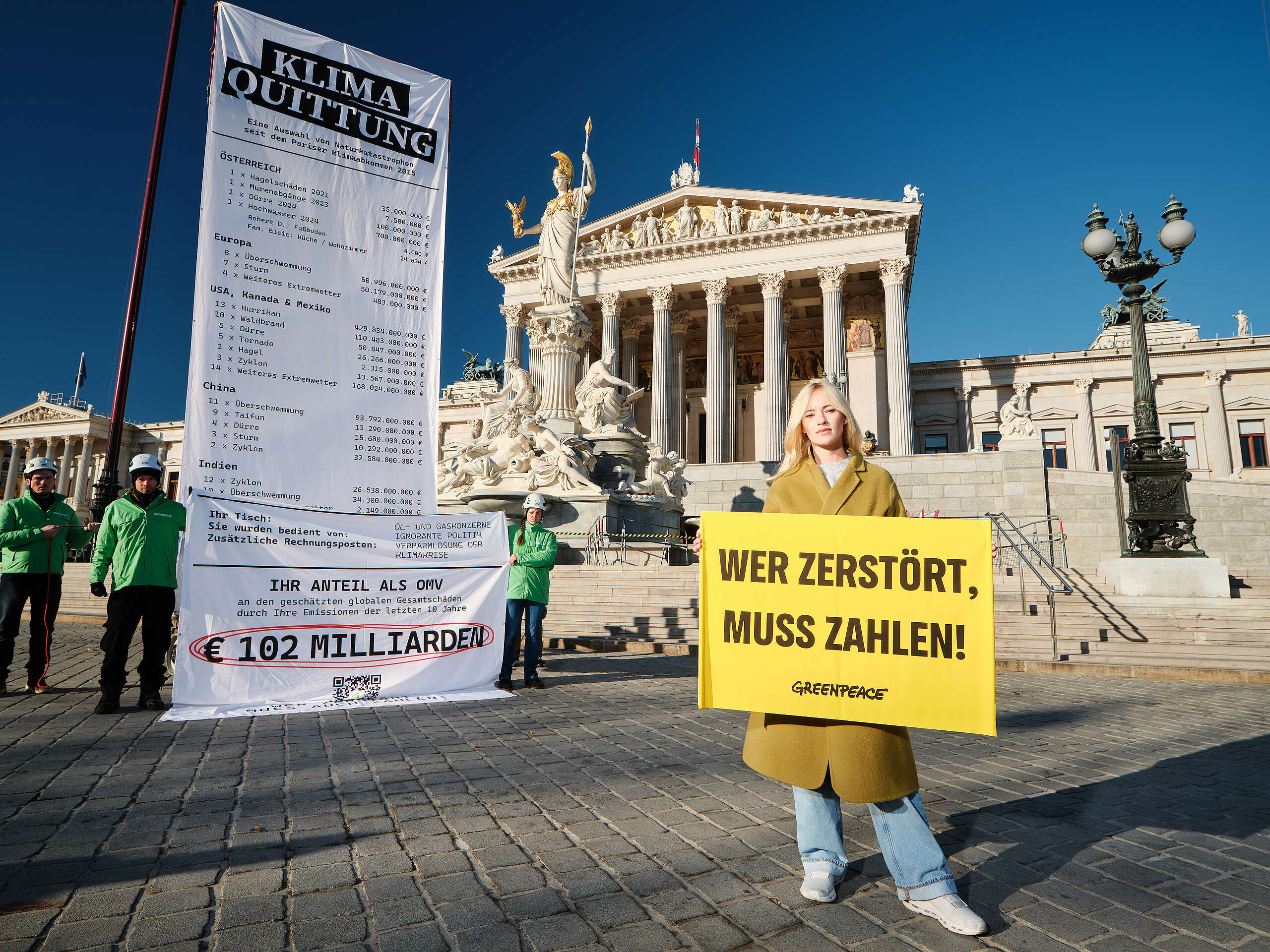
10. Acapulco, Guerrero, Mexico – 4 November
The estimated damage caused in Mexico by the impacts of extreme weather events during the last 10 years is over 177 billion pesos (over US$ 9 billion). Greenpeace Mexico activists unfurled a 24-meter-long climate bill outside a building damaged two years ago by Hurricane Otis on the coast of Acapulco, in the state of Guerrero, a building that remains abandoned to this day.
While parts of Acapulco have been rebuilt, many neighbourhoods and communities in other parts of the state still lack assistance. This is the same reality faced by numerous families in various states across the country. A few years ago it was Tabasco; now, affected by the recent extraordinary rains in states like Veracruz, Hidalgo, Puebla, San Luis Potosí, and Querétaro, people are living in devastated communities.
“This action shows that the people are paying the price of the climate crisis, while the government continues to allocate public funds to build fossil fuel megaprojects that catalyse climate change,” said Viridiana Lázaro, a Greenpeace Mexico campaigner who is part of the Greenpeace delegation attending COP30.
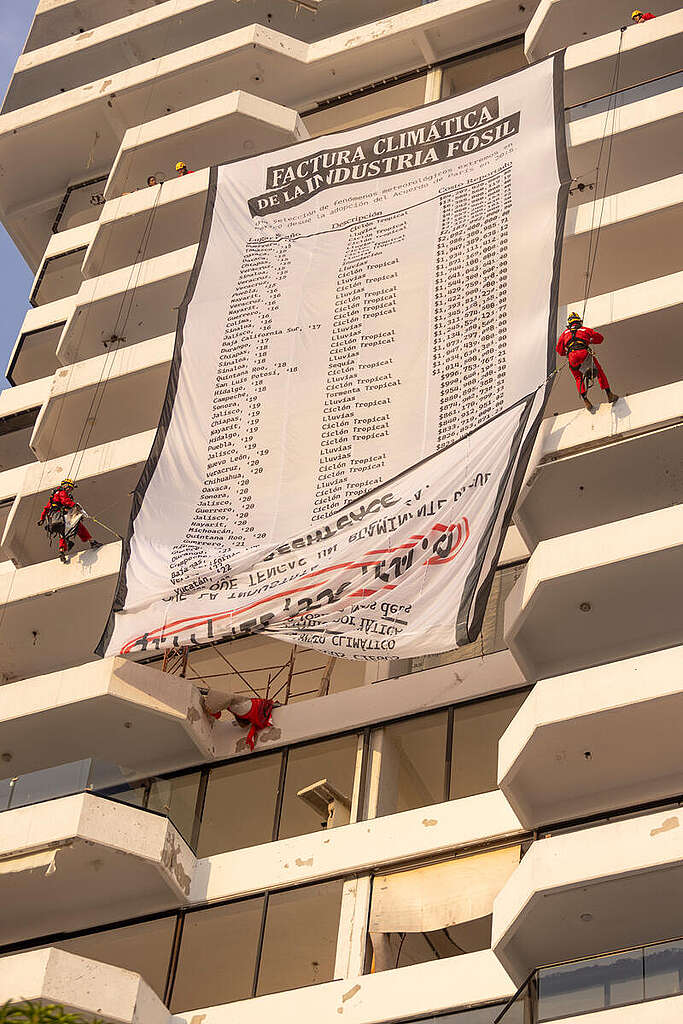
COP30 in Belém
This global relay is more than a protest. We’re taking the US$5 trillion Climate Bill to COP30, the international climate conference in Belém, Brazil, where world governments will need to choose on which side they stand: rich polluters or the people. We demand world leaders commit to:
- End fossil fuel expansion: Immediately end all new oil, gas, and coal projects.
- Make polluters pay: Mandate that fossil fuel companies pay their fair share.
At the same time, 4,000 kilometres away in Nairobi, the giant bill will be visible to negotiators in talks over a UN Tax Convention – a historic opportunity to elicit commitment to changing the tax system. Our delegation will be there to help break up the power of extreme wealth and hold oil and gas corporations and the super-rich to account for damage they’ve done.
To succeed, our campaign will require everyone to come together. Join us, along with more than 250,000 people from around the world who support the Polluters Pay Pact.
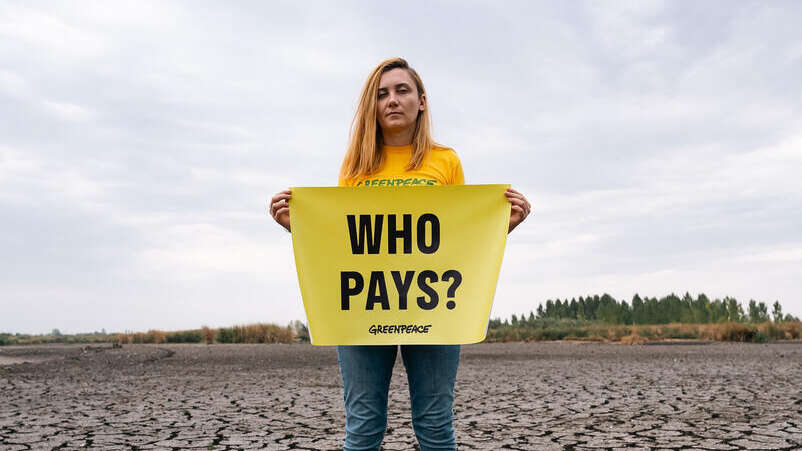
Sign the pact, record your story. Join the global movement to make polluters pay.
Join the movementTal Harris is the Global Media Lead of Greenpeace International’s Stop Drilling Start Paying. He is based in Geneva.

